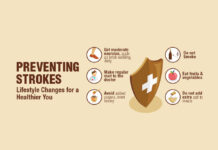
JOINT PAIN CAUSED BY ARTHRITIS CAN BE EXTREMELY DISABLING AND PAINFUL. HERE ARE SOME NATURAL SOLUTIONS TO EASE YOUR PAIN AND EVEN HELP PREVENT ARTHRITIS.
Arthritis causes severe joint pain and inflammation, which can mean not being able to get dressed, open a door, or even hold a fork. In Canada, approximately one in six (nearly four million) Canadians over the age of 14 suffers from arthritis. Here’s how to reduce your risk, naturally, or help reduce the pain if you suffer from arthritis.
WHAT IS ARTHRITIS?
In medical lingo, the suffix “itis” means inflammation. Arthritis, then, means any disease that involves inflammation of the joints — the places where bones come together (such as in the knees, wrists, hands, fingers, elbows, feet and toes). Although arthritis can come at any age, it is more common as we age because the components of the joint begin to deteriorate, most notability the cartilage, and the joint area begins to dry out. Healthy cartilage is made up of 65 to 80 per cent water. A joint is like a sponge filled with synovial fluid. When pressure is applied to the joint, the fluid is squeezed out of the cartilage acting like a shock absorber. When the pressure is reduced, the fluid is pulled back into the cartilage. With wear, cartilage deteriorates reducing the smooth protective buffer between bones, causing inflammation and pain.
CAN HERBAL SUPPLEMENTATION HELP?
Since arthritis is a disease of inflammation, the most effective treatment is anything that fights inflammation. Medical management
of arthritis usually starts with ibuprofen and other anti-inflammatory
medications, however there are herbal supplements that can help. These include:
Glucosamine Sulfate
Glucosamine sulfate provides the joints with the building blocks they need to repair damage caused by osteoarthritis or injuries. As we age, our bodies naturally produce less glucosamine, making it more difficult to restore cartilage that is lost through normal wear and tear; this may contribute to osteoarthritis. Glucosamine helps stop cartilage deterioration while reducing or eliminating pain and improving joint function. It does this by stimulating the manufacture of glycosaminoglycans (GAGs), key components of cartilage, making it very useful for degenerative joint disease or osteoarthritis.
Chondroitin Sulfate
Chondroitin supports and enhances cartilage production. It inhibits inflammation and removes and/or prevents the formation
of fibrin, thrombi, plaque in synovium and/or subchondral blood vessels. Chondroitin also holds water and nutrients, thus allowing other molecules to move through cartilage providing lubrication.
MSM
MSM is thought to act in three main ways. It blocks pain, acts as a sulfur donor to repair cartilage, and is an anti-inflammatory.
Celadrin
Celadrin inhibits inflammation in endothelial cells, reduces the production of the immune factor IL-6, controls other immune factors responsible for inflammation, and lubricates joints.
GIVE YOUR JOINTS A NUTRITION BOOST
If you are overweight, losing weight can be an effective strategy at helping to reduce the effects of arthritis. Being overweight puts extra stress on the joints, which escalates the risk of wear and tear. Also, body fat is not an inert substance. Fat is metabolically active, capable of producing hormones and chemicals that actually increase levels of inflammation. By losing weight — and avoiding excess calories that can cause weight gain — you’ll automatically reduce inflammation in your body.
Even if you’re not overweight, changing the way you eat can have a positive effect on arthritis by reducing inflammation. If you have arthritis you should avoid saturated and trans fats. Saturated fats are found in animal products such as fatty beef or pork, poultry skin and full-fat dairy. Saturated fats are also found in palm oil and palm-kernel oil, which are often found in packaged baked goods. Trans fats were created by scientists to give baked goods a longer shelf life. Trans fats are thought to be at least as damaging as saturated fats in terms of inflammation and other health problems, and possibly more so.
It’s also wise to limit simple and refined carbohydrates such as sugary foods, white-flour baked goods, white rice, bread and crackers. These foods set up a state of inflammation in the body, increasing pro-inflammatory compounds in the body. Instead focus on eating foods rich in the following nutrients:
Omega-3 Fatty Acids: The healthiest of fats for people with arthritis
or other inflammatory disorders are omega-3 fatty acids. More than a dozen studies have demonstrated that omega-3 fish oils can drastically reduce symptoms of rheumatoid arthritis. Some of the best foods for omega-3 fatty acids include salmon, herring, mackerel
(not king), sardines, anchovies, rainbow trout, Pacific oysters,
ground flaxseeds, chia seeds, walnuts, seaweed and soybeans.
Extra-Virgin Olive Oil: In addition to healthy monounsaturated fats, olive oil contains a natural compound called oleocanthal, which may help prevent arthritis-related inflammation. These compounds block the same inflammatory pathways as ibuprofen and aspirin, medications commonly used to fight arthritis pain. For the highest antioxidant content, choose “extra virgin” olive oil – the stronger the taste, the higher the amounts of oleocanthal
the oil is likely to have.
Antioxidants: Antioxidants protect the body from the effects of cell-damaging free radicals and are a critical part of an anti-inflammation
diet. Research has also demonstrated that certain antioxidants may help prevent arthritis, slow its progression and relieve pain. The best antioxidants in terms of arthritis relief and prevention are vitamin C, beta-carotene, beta-cryptoxanthin, quercetin and anthocyanins. Vitamin C is found in guava, bell peppers, oranges, grapefruits, strawberries, pineapples, kohlrabi, papayas, lemons, broccoli, kale, potatoes and Brussels sprouts. Beta-carotene is found in sweet potatoes, carrots, kale, butternut squash, turnip greens, pumpkins, mustard greens, cantaloupes, sweet red peppers, apricots and spinach. Beta-cryptoxanthin is found in winter squash, pumpkins, persimmons, papayas, tangerines, peppers (red chili and red bell), corn, oranges, apricots, carrots, nectarines and watermelon. Quercetin is found in onions, kale, leeks, cherry tomatoes, broccoli, blueberries, black currants, elderberries, lingonberries, apricots, red apples with skin and red/purple/black grapes. Anthocyanins are found in blackberries, black currents, blueberries, eggplant, elderberries, raspberries, cherries, boysenberries, red/black/purple grapes, strawberries, plums, cranberries, rhubarb, red onions and apples.
Vitamin D: Studies have shown that getting adequate amounts of vitamin D reduces the risk of both rheumatoid arthritis and osteoarthritis. Among people who already have osteoarthritis, those who have a vitamin D deficiency are more likely to develop worsening disability over time. Some of the best foods for vitamin D include wild salmon, mackerel (not king), sardines, herring, low-fat milk, soymilk, egg yolks and UV-treated mushrooms.
Spices: Certain spices seem to have anti-inflammatory effects and therefore should be considered for arthritis treatment. Among the most promising are ginger and turmeric. Ginger has been shown to lessen the pain of knee osteoarthritis when taken in highly purified, standardized supplement form. Scientific studies
have shown that turmeric may help arthritis by suppressing inflammatory body chemicals. VM
LIFESTYLE TIPS TO KEEP YOUR JOINTS HEALTHY
› Create a positive, healthy work environment. Arrange your workstation so you’ll be comfortable in a variety of positions: typing on your keyboard, reading the screen with your hand on your mouse or writing on a desk surface.
› Stand tall. By maintaining good posture, your muscles and skeletal system work together to put less strain on your joints.
› Lead a balanced life. Try to maintain a nice, even balance between motion and rest.
› Pamper yourself. Relaxing baths, massages and acupuncture can relieve pain and help you relax, meaning your joints can also relax.
› Stretch! With regular stretching, your joints won’t just retain mobility; they’ll remain more limber.
› Gain muscle. Weight training will improve your balance, help you lose weight, and strengthen your bones.
› Act your age! Take it easy at first when trying new activities, and slowly increase the demands on your body.












